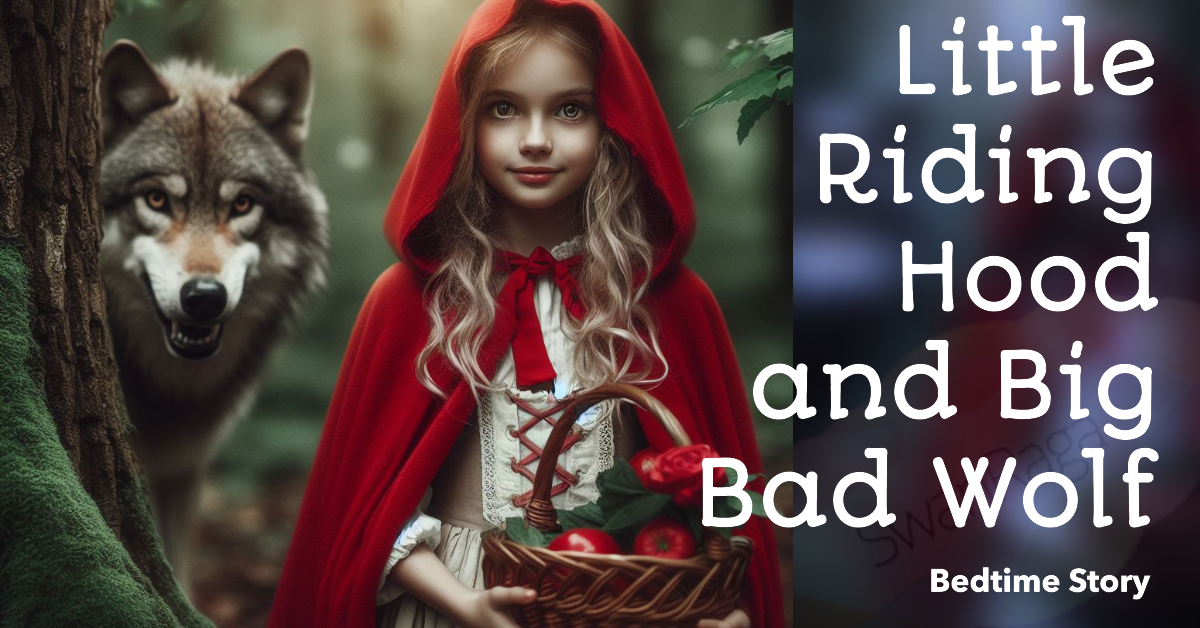“Little Red Riding Hood”: This cautionary bedtime tale teaches children about the importance of listening to their parents and not talking to strangers. It also underscores the value of being cautious and aware of one’s surroundings.
Once upon a time, in a little village, there lived a girl named Little Red Riding Hood. She was called “Little Red” because she loved to wear a bright red hood that her grandmother had made for her. Little Red was a sweet and kind girl.
One sunny morning, Little Red’s mother called her and said, “Little Red, your dear grandmother is not feeling well. She lives in a house deep in the forest. Would you be a good girl and take this basket of fresh fruits and some cookies to her?”
Little Red nodded and happily took the basket from her mother. “Of course, Mama,” she said.
“But remember,” her mother warned, “stay on the path and do not talk to strangers. The forest can be a tricky place.”
Little Red promised to be careful and started her journey through the forest. She skipped along, enjoying the beautiful trees and singing to herself.
As she walked, she met a friendly rabbit who asked, “Where are you going, Little Red?”
“I’m going to visit my sick grandmother,” Little Red replied cheerfully.
The rabbit smiled and said, “Oh, how nice! Please be careful and stay on the path.”
Little Red thanked the rabbit and continued on her way.
But soon, she encountered a sly wolf hiding behind a tree. The wolf had a mischievous plan in mind. He asked Little Red, “Where are you going, little girl?”
Little Red remembered her mother’s warning and replied, “I’m going to visit my sick grandmother.”
The wolf, pretending to be kind, said, “Oh dear, that’s a long way through the forest. Why don’t you take the shorter path over there? It will get you to your grandmother’s house much faster.”
Little Red thought the wolf seemed nice and trusted his advice. She strayed from the path and followed his directions.
Meanwhile, the wolf took a shortcut to reach the grandmother’s house before Little Red.
When Little Red finally arrived at her grandmother’s house, she was surprised. The door was open, and something didn’t feel right. She cautiously went inside.
There, lying in bed, was her grandmother, but something was very wrong. “Grandma, what big eyes you have!” Little Red exclaimed.
“All the better to see you with, my dear,” replied the wolf, who had disguised himself as the grandmother.
Little Red then noticed the big ears and big teeth of the wolf. She realized her mistake.
“Grandma, what big ears you have!” she said.
“All the better to hear you with, my dear,” said the wolf.
“Grandma, what big teeth you have!” Little Red said, trembling with fear.
“All the better to eat you with!” shouted the wolf and leaped out of the bed.
But just in time, a kind woodsman who had heard the commotion burst into the house and saved Little Red and her grandmother. The wolf ran away into the forest and was never seen again.
Little Red learned an important lesson that day. She understood the value of listening to her mother’s advice and being cautious of strangers. She was grateful to the woodsman for saving her and her grandmother.
From that day on, whenever she wore her bright red hood, she remembered the adventure and the importance of being safe.
And they all lived happily ever after.
The story of “Little Red Riding Hood” teaches several important lessons to kids:
- Listening to Parents: Little Red Riding Hood’s mother warns her not to talk to strangers and to stay on the path. This teaches children the importance of listening to their parents or caregivers, who offer guidance and advice to keep them safe.
- Stranger Danger: The encounter with the wolf highlights the concept of “stranger danger.” Children learn that not everyone they meet may have good intentions, and it’s essential to be cautious when interacting with people they don’t know.
- Following Instructions: Little Red strays from the path, which leads to a dangerous situation. This part of the story emphasizes the importance of following instructions and staying on the right track, both in literal and metaphorical terms.
- Critical Thinking: Children can learn to be critical thinkers by recognizing when something doesn’t seem right. Little Red eventually realizes that the “grandmother” doesn’t look or sound like her real grandmother, which prompts her to question the situation.
- Resilience and Help: Little Red’s resourcefulness and the woodsman’s timely intervention demonstrate that there are people who can help in difficult situations. This encourages children to seek help if they ever find themselves in trouble.
- Consequences of Actions: The story shows that actions have consequences. Little Red’s decision to talk to the wolf and leave the path leads to a dangerous encounter. This teaches children that their choices can have positive or negative outcomes.
- Trustworthy Adults: The woodsman in the story is a trustworthy adult who helps Little Red and her grandmother. This reinforces the idea that there are responsible and caring adults whom children can rely on when needed.
Overall, “Little Red Riding Hood” is a cautionary tale that encourages children to be cautious, think critically, and make safe choices. It emphasizes the importance of heeding parental advice and being aware of potential dangers while still conveying the idea that help is available when required.
